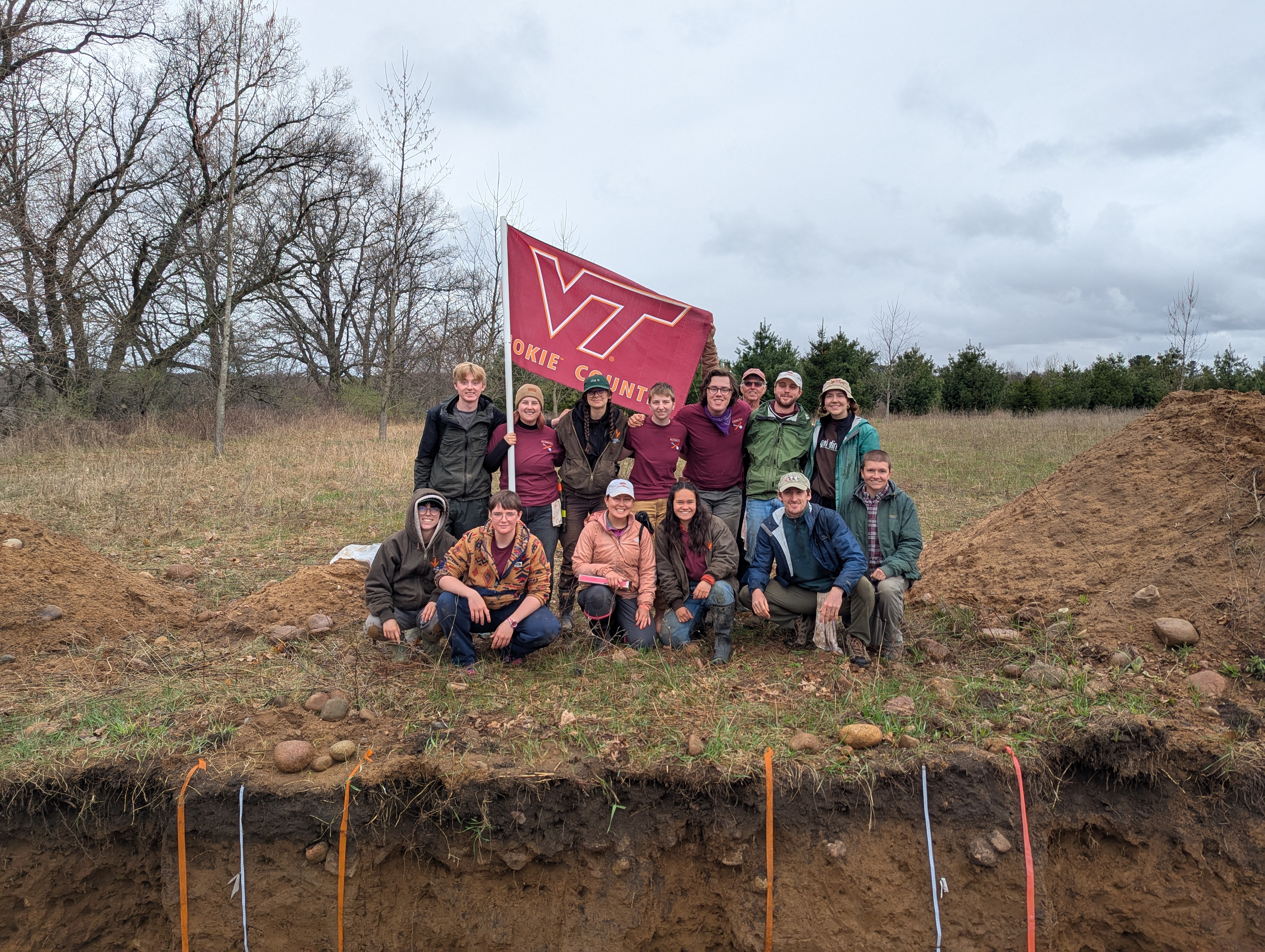Virginia Tech finishes seventh at 2025 National Soil Judging Championship
Hokies showcase teamwork and technical skills in Wisconsin’s glacial soils, earning top-30 finishes in both individual and alternate contests.
The Virginia Tech Soil Judging Team from left back row: Danielle Davies, Joey Johnson, Sam Herrin, Leilani Hyatt, Will Ubben, Reid Flessa, Liz Eroshenko, and Clara Betts. From left front row: coach John Galbraith, assistant coach Adam Devlin, Delia Alcorn, CJ Rufe, Sinclair Anderson, Rachel Parmele, and assistant coach Will Hernandez. Photo Courtesy of John Galbraith.

Battling against 27 teams in Stevens Point, WI, the Virginia Tech Soil Judging Team finished in seventh place overall at the 2025 National Collegiate Soils Contest.
At the four-day event sponsored by the Soil Science Society of America, students visited practice pits where they were tasked with identifying horizons, collecting samples, describing those samples, and answering questions regarding the soil's hydrology, classification, and interpretation.
“I am extremely proud of our students,” said John Galbraith, the team's coach and a professor of soil and wetland sciences at the School of Plant and Environmental Sciences. “They practiced hard, had a great attitude, listened well, learned a lot, and represented the university, college, school, and themselves very well.”
Several students excelled in the individual competitions at the event, with Sinclair Anderson placing 14th out of 106 participants, Liz Eroshenko 16th, Will Ubben 26th, and Rachel Parmele 48th. In a separate alternate contest, Clara Betts placed first out of 93, followed by Leilani Hyatt in second, Delia Alcorn in seventh, and Sam Herrin in eighth.
The competition landscape featured a variety of glacial landforms, such as plains formed by glacial debris (till and outwash), ridges (moraines), mounds (kames), depressions (kettles), and streamlined hills (drumlins and eskers), all shaped by both recent and ancient glaciers. The area also included glacial lake plains and sand dunes, offering a complex environment for soil study.
Most of the soils were sandy and classified into several types, including Udipsamments (very sandy soils common in humid climates), Hapludalfs and Glossudalfs (fertile forest soils with clay-enriched sublayers), and some Argiudolls (rich, dark prairie soils ideal for agriculture). A few Spodosols—acidic soils often found in conifer forests were also encountered. As well as a rare and geologically interesting ice-walled lake plain deposit located on a hilltop.
Bryant Scharenbroch, host of the contest and associate professor of soil science at the University of Wisconsin, held a lecture on the unique soils and geology of the area, and participants were able to see how well the soils were for loading rates, hydric soils, growing potatoes, septic tanks drain fields, houses with basements, local roads, and ecological site descriptions.
“We are grateful to all of those who donated or took part in our fundraisers to help send this team to the national contest,” said Galbraith. “The Soil Judging Team is very grateful for the financial support provided by VAPSS and its members and the School of Plant and Environmental Sciences at Virginia Tech.”
The team of 12 students was coached by Galbraith, Will Hernandez, a graduate student, and Adam Devlin, a former soil judger at Virginia Tech. Anderson is a junior environmental science major from Springfield, VA; Eroshenko is a senior environmental sciences major from Richmond, VA; Ubben is a senior environmental sciences major from Vienna, VA; and Parmele is a junior environmental science major from Ashburn, VA. Betts is a junior ecological restoration major from Henrico, VA; Hyatt is a senior environmental science (minors in setland science and geosciences) from Tucson, Arizona; Davies is a senior crop and soil science, from Bergen County NJ; Herrin is a senior environmental science major from Fredericksburg VA; Alcorn is a senior from Reston, VA majoring in crop and soil science; CJ Rufe is a junior environmental horticulture major from Richmond, VA; Flessa is a senior majoring in environmental resource management from Cincinnati, OH; and Johnson is a sophomore double majoring in agribusiness management and crop & soil science from Madison, VA.



